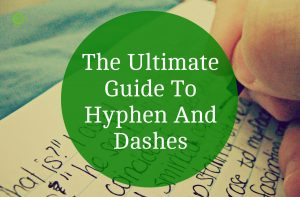Is learning the English language really tough? Grammar is something that makes you go nuts? Most people feel that while writing that English is a bit tough. They tend to get confused with the tenses, punctuation marks and use of proper words.
We all are familiar with the fact that writing itself is very contextual. In a professional world, your content work has to be to the point whereas in fictional or article writing you can provide a comprehensive amount of data.
Sometimes the editors themselves get confused with the different work from different people. One such thing that is often mistaken or incorrectly used is – Dashes and Hyphens.
Before we move ahead to know the difference between the two you need to understand the difference between a hyphen and a dash.
Hyphens – When A Writer Should Use Hyphens?
As we know, in English Grammar, hyphens generally perform a function when they need to
- Build a link between compound adjectives or words.
- They can be used with the prefixes.
- It can be used to represent the expression with isolation as well ( for example you can check all the element words like pre- or -er)
- Hyphens are also used when a link needs to build or spelled out with numerical terms or representation. (For instance, you can check the word ninety-nine or some other)
- You need to make sure that hyphens are considered as phrasal adjectives which are preceding with a noun and it can be combined with almost similar-looking words such as comparative adverbs – Better, Much, Well, etc.
The Three Types of Hyphens and Their Uses
There are different types of hyphens that can be used in English Grammar. You can easily see how different they are from each other in their usage and practice.
1. Use Of Soft Hyphen
It will symbolize something to show how the words break at the end of the line.
2. Checking Out Non-Breaking Hyphen
It is completely opposite to the use of a soft hyphen. You will see that it will not allow a line break after it or before it.
3. Minus Sign
It is mostly used at mathematical instances that find a reference in written work. You might wonder that why can’t you just use an en dash or hyphen but you must ensure that they do not look the same. In case you are working on an academic book which includes a lot of numerical things then using minus sign is mandatory.
Different Types of Dashes and How to Use Them
Now let’s know-how and where to use dashes?
1. Checking Out Angled Dash
It can be really tricky to know when this type of dash can be used in the content. It is mostly used in the symbolic logic or while explaining about some formulae.
2. Use Of Tilde
It is also called as pinata which is used in the middle of the line. Sometimes writers used it as a fancy dash. But if you check officially it is meant to be used as ‘approximately’. When you are not sure about any data or something then you can use it.
3. Use Of En Dash
First of all, you need to know that these are the real dashes and the en-dash is considered to be half of the width of an em-dash. You can easily use it to indicate the number ranges. Sometimes you also replace it with a hyphen while using in the compound nouns.
4. Figure Dash
Just by looking at the dashes you won’t be able to get the difference between the figure dash and en dash. It is wide enough to show the standard numeral and mostly used in phone numbers ( for example 776-445). Sometimes to make them look and feel better the typographer use it. It will help them to sigh happily and in fact, no one will take notice of it.
Conclusion:
By now, you have got a good grip on all the techniques and working of the dashes. It will make your writing work much better and skillful.


